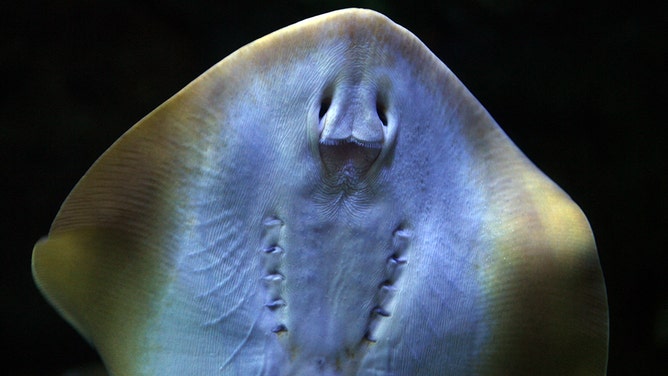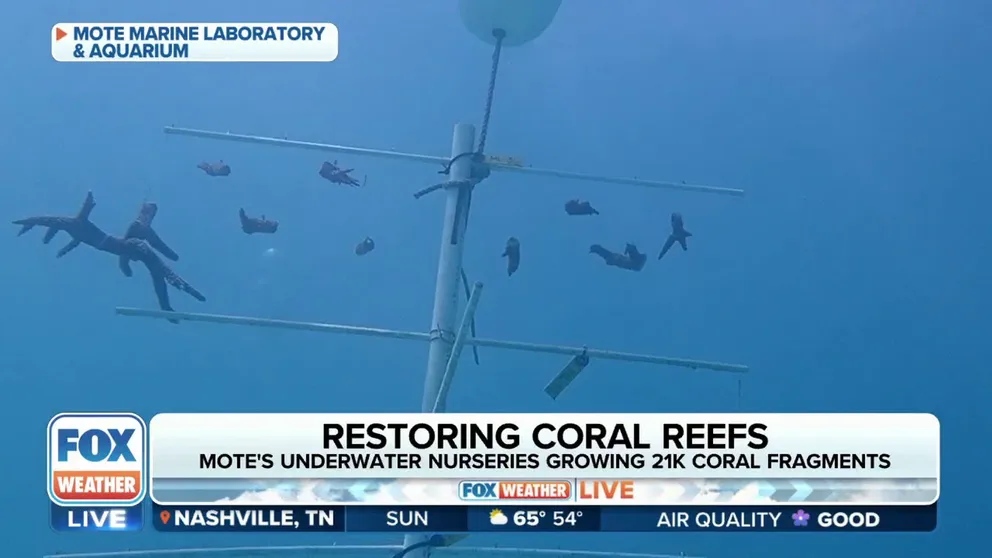Charlotte the pregnant stingray has a 'reproductive disease,' aquarium says
The aquarium initially thought Charlotte's pregnancy was due to parthenogenesis, a type of asexual reproduction. This week the Aquarium and Shark Lab announced Charlotte has a "rare reproductive disease."
How researchers work to restore declining coral reefs as oceans warm
FILE VIDEO: Dr. Jason Spadaro, Program Manager of Mote Coral Reef Restoration and Research Program, joined FOX Weather on Sunday and explained how researchers are not only trying to preserve what’s left of our coral reefs, they’re trying to restore function to those critical ecosystems that support marine life.
HENDERSONVILLE, N.C. – A North Carolina aquarium announced that a stingray previously believed to be pregnant without a male companion has a rare reproductive disease.
The Aquarium and Shark Lab in Hendersonville released a statement Thursday confirming that the stingray Charlotte has developed a rare reproductive disease. The statement did not specify the disease or the status of her supposed pregnancy. Attempts to gather more information from the aquarium were not immediately successful.
"Charlotte has developed a rare reproductive disease that has negatively impacted her reproductive system," the aquarium said. "The findings are truly a sad and unexpected medical development. Our priority is to focus on Charlotte’s health and well-being."
Initial pregnancy announcement
In February, the aquarium in the Blue Ridge Mountains announced Charlotte's pregnancy. They noted that she had not shared a tank with a male of her species in at least eight years. At that time, the aquarium believed she was carrying up to four pups and could give birth within two weeks.
US NAMED SHARK ATTACK CAPITAL OF THE WORLD IN 2023
What is parthenogenesis, and how does it impact reproduction?
The aquarium initially thought Charlotte's pregnancy was due to parthenogenesis, a type of asexual reproduction in which offspring develop from unfertilized eggs, meaning no genetic contribution from a male.

File photo: A Bluespotted stingray (Taeniura Lymna) swims in the Aquarium of the Pacific complex in Long Beach, California, on Nov. 8, 2006.
(GABRIEL BOUYS/AFP / Getty Images)
While rare, this phenomenon can occur in some insects, fish, amphibians, birds, and reptiles, but not in mammals. Documented cases include California condors, Komodo dragons, and yellow-bellied water snakes.
How does a stingray get pregnant without a mate?
The vet noted a few cases of asexual reproduction without fertilization in stingrays, but this is the first known case of parthenogenesis in a captive California-round stingray.
An expert on stingrays said it would have been impossible for Charlotte to have mated with one of the five small sharks that share her tank, despite news reports suggesting that was the case after the aquarium’s executive director, Brenda Ramer, joked about a possible interspecies hookup.
Kady Lyons, a research scientist at the Georgia Aquarium in Atlanta who is not involved with the North Carolina Aquarium, said Charlotte’s pregnancy is the only documented example of this species – round stingrays.
"I’m not surprised, because nature finds a way of having this happen," she said.
THESE JELLY-LIKE SEA CREATURES COULD INSPIRE NEW UNDERWATER ROBOTS, STUDY FINDS
To be clear, Lyons said, these animals are not cloning themselves. Instead, a female’s egg fuses with another cell, triggering cell division and creating an embryo. The cell that fuses with the egg is known as a polar body. They are produced when a female creates an egg that isn't used.
"We don’t know why it happens," Lyons said. "Just that it’s kind of this really neat phenomenon that they seem to be able to do."
Future steps for Charlotte's care
As Charlotte’s health condition unfolds, the aquarium emphasizes its commitment to her well-being. The development has brought attention to the complexities and unexpected challenges in marine life care and the rare parthenogenesis in stingrays.
For more updates on Charlotte’s condition and other marine life news, follow the Aquarium and Shark Lab’s official channels.
Kelly Hayes and the Associated Press contributed to this story. It was reported from Los Angeles.
